Business Law: UK Legal Systems, Legislation Impact, and Formations
VerifiedAdded on 2024/06/28
|21
|5428
|62
Report
AI Summary
This report provides an overview of business law in the UK, focusing on the legal systems, key legislation, and their impact on businesses, particularly startups. It details the sources of law, including legislation, common law, and European Union law, and elaborates on the government's role in law-making. The report assesses the effectiveness of the legal system and the role of the Law Commission in law reform. It further examines the impact of contract and employment law on businesses, including workers' compensation, occupational health and safety, equal opportunities, and anti-discrimination measures. The different types of business formations, their advantages, and disadvantages are discussed. Finally, it recommends solutions for resolving business disputes and compares diverse sources of support and advice.

BUSINESS LAW
1
1
Paraphrase This Document
Need a fresh take? Get an instant paraphrase of this document with our AI Paraphraser
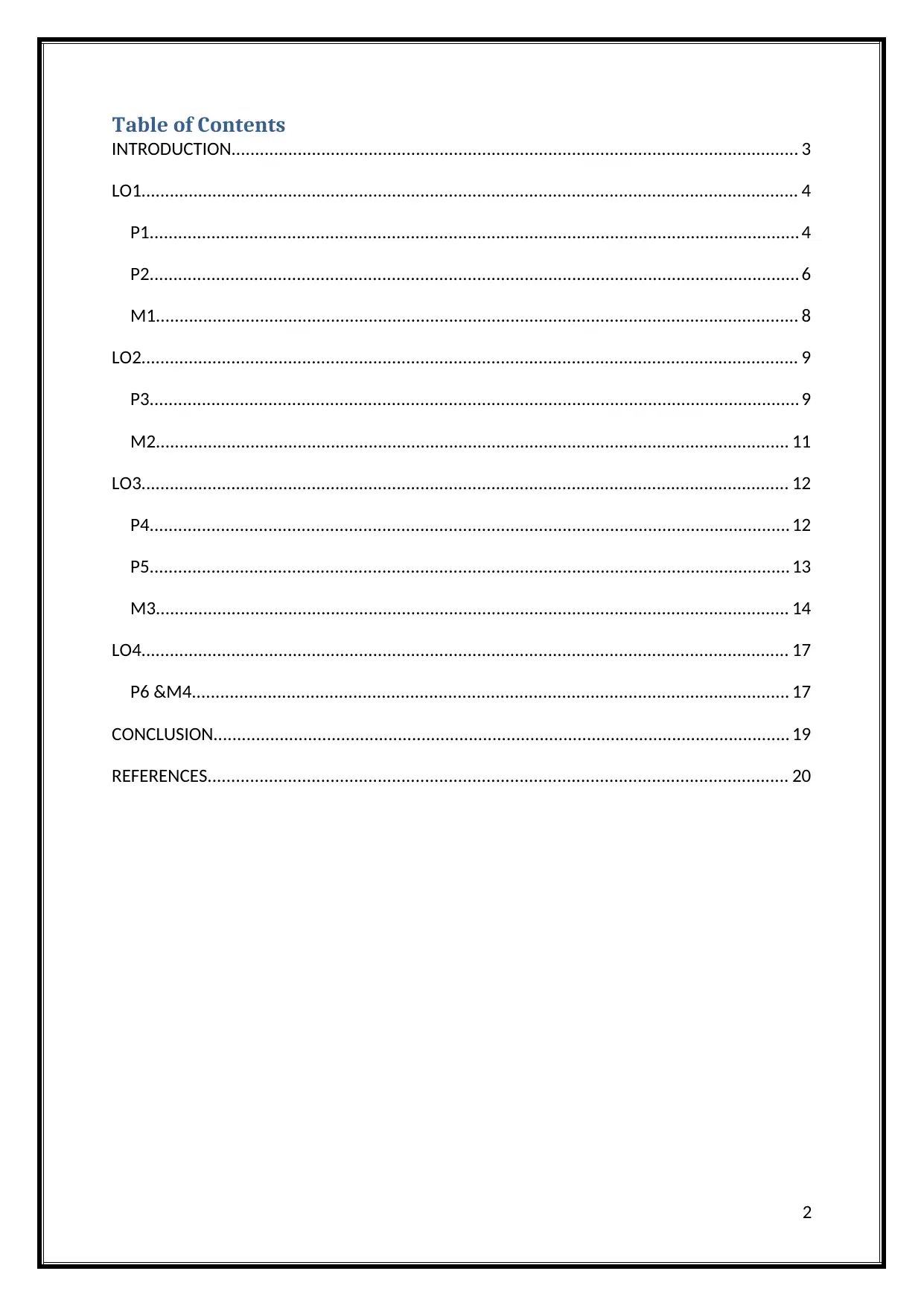
Table of Contents
INTRODUCTION........................................................................................................................ 3
LO1........................................................................................................................................... 4
P1......................................................................................................................................... 4
P2......................................................................................................................................... 6
M1........................................................................................................................................ 8
LO2........................................................................................................................................... 9
P3......................................................................................................................................... 9
M2...................................................................................................................................... 11
LO3......................................................................................................................................... 12
P4....................................................................................................................................... 12
P5....................................................................................................................................... 13
M3...................................................................................................................................... 14
LO4......................................................................................................................................... 17
P6 &M4.............................................................................................................................. 17
CONCLUSION.......................................................................................................................... 19
REFERENCES........................................................................................................................... 20
2
INTRODUCTION........................................................................................................................ 3
LO1........................................................................................................................................... 4
P1......................................................................................................................................... 4
P2......................................................................................................................................... 6
M1........................................................................................................................................ 8
LO2........................................................................................................................................... 9
P3......................................................................................................................................... 9
M2...................................................................................................................................... 11
LO3......................................................................................................................................... 12
P4....................................................................................................................................... 12
P5....................................................................................................................................... 13
M3...................................................................................................................................... 14
LO4......................................................................................................................................... 17
P6 &M4.............................................................................................................................. 17
CONCLUSION.......................................................................................................................... 19
REFERENCES........................................................................................................................... 20
2
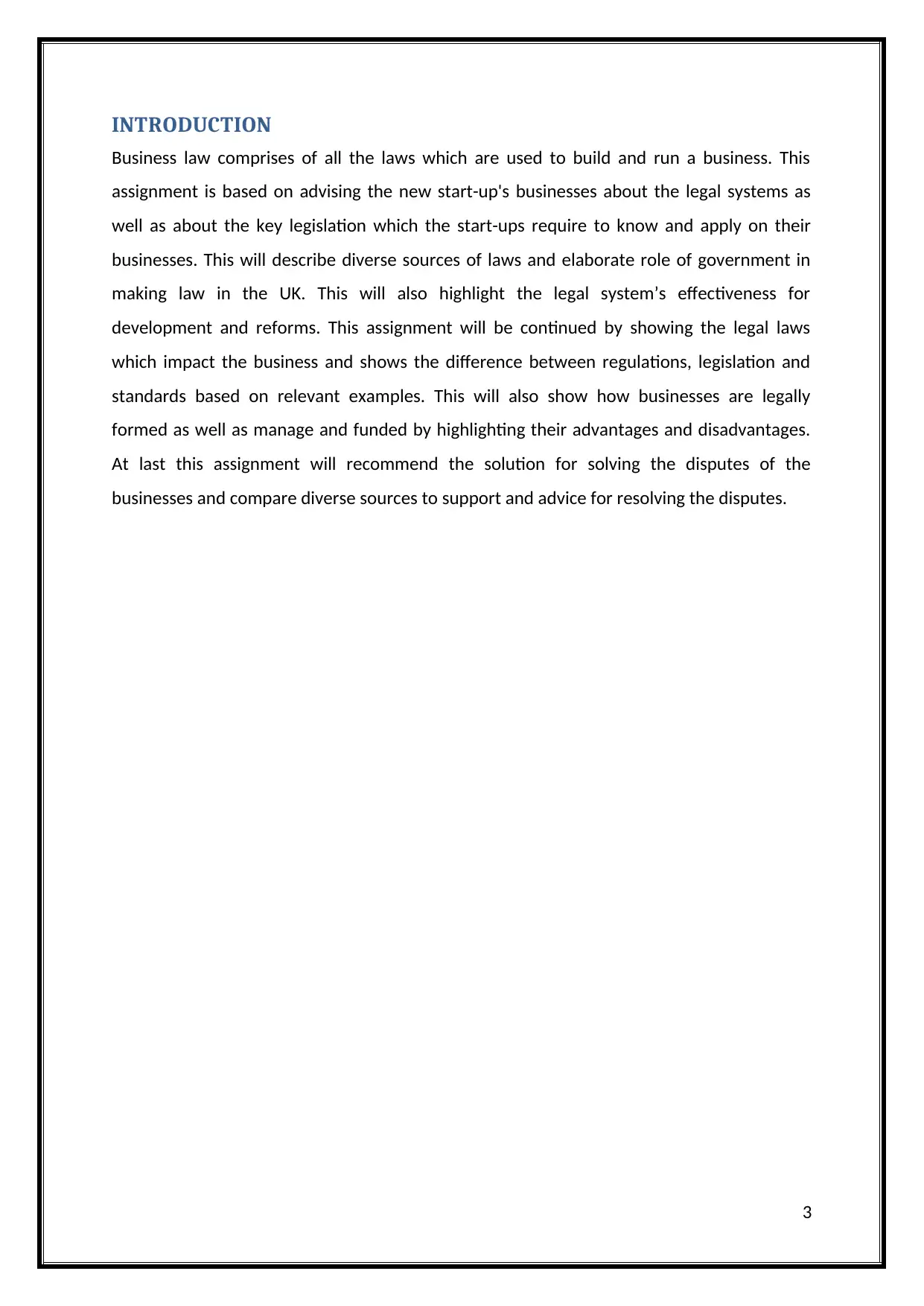
INTRODUCTION
Business law comprises of all the laws which are used to build and run a business. This
assignment is based on advising the new start-up's businesses about the legal systems as
well as about the key legislation which the start-ups require to know and apply on their
businesses. This will describe diverse sources of laws and elaborate role of government in
making law in the UK. This will also highlight the legal system’s effectiveness for
development and reforms. This assignment will be continued by showing the legal laws
which impact the business and shows the difference between regulations, legislation and
standards based on relevant examples. This will also show how businesses are legally
formed as well as manage and funded by highlighting their advantages and disadvantages.
At last this assignment will recommend the solution for solving the disputes of the
businesses and compare diverse sources to support and advice for resolving the disputes.
3
Business law comprises of all the laws which are used to build and run a business. This
assignment is based on advising the new start-up's businesses about the legal systems as
well as about the key legislation which the start-ups require to know and apply on their
businesses. This will describe diverse sources of laws and elaborate role of government in
making law in the UK. This will also highlight the legal system’s effectiveness for
development and reforms. This assignment will be continued by showing the legal laws
which impact the business and shows the difference between regulations, legislation and
standards based on relevant examples. This will also show how businesses are legally
formed as well as manage and funded by highlighting their advantages and disadvantages.
At last this assignment will recommend the solution for solving the disputes of the
businesses and compare diverse sources to support and advice for resolving the disputes.
3
⊘ This is a preview!⊘
Do you want full access?
Subscribe today to unlock all pages.

Trusted by 1+ million students worldwide
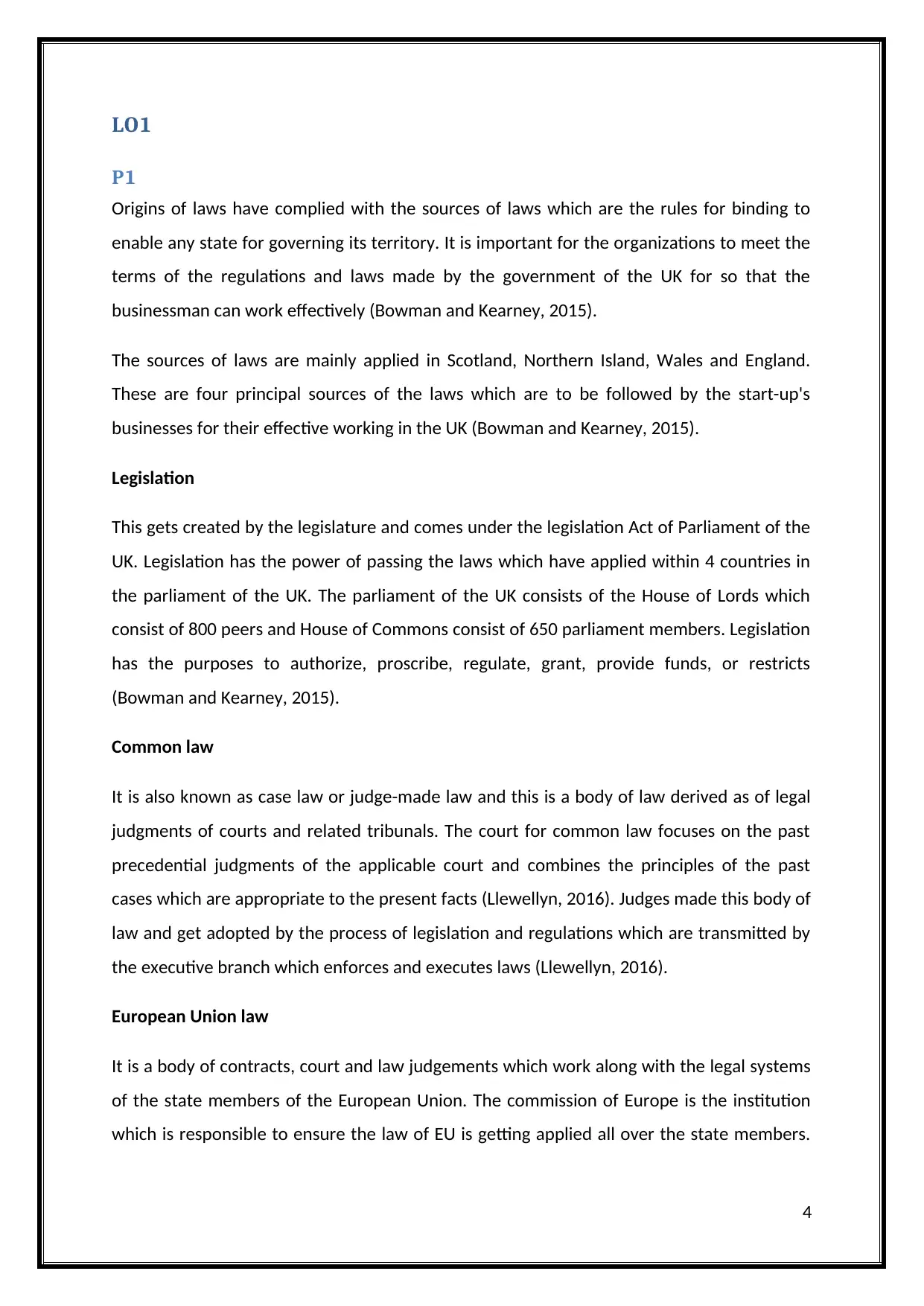
LO1
P1
Origins of laws have complied with the sources of laws which are the rules for binding to
enable any state for governing its territory. It is important for the organizations to meet the
terms of the regulations and laws made by the government of the UK for so that the
businessman can work effectively (Bowman and Kearney, 2015).
The sources of laws are mainly applied in Scotland, Northern Island, Wales and England.
These are four principal sources of the laws which are to be followed by the start-up's
businesses for their effective working in the UK (Bowman and Kearney, 2015).
Legislation
This gets created by the legislature and comes under the legislation Act of Parliament of the
UK. Legislation has the power of passing the laws which have applied within 4 countries in
the parliament of the UK. The parliament of the UK consists of the House of Lords which
consist of 800 peers and House of Commons consist of 650 parliament members. Legislation
has the purposes to authorize, proscribe, regulate, grant, provide funds, or restricts
(Bowman and Kearney, 2015).
Common law
It is also known as case law or judge-made law and this is a body of law derived as of legal
judgments of courts and related tribunals. The court for common law focuses on the past
precedential judgments of the applicable court and combines the principles of the past
cases which are appropriate to the present facts (Llewellyn, 2016). Judges made this body of
law and get adopted by the process of legislation and regulations which are transmitted by
the executive branch which enforces and executes laws (Llewellyn, 2016).
European Union law
It is a body of contracts, court and law judgements which work along with the legal systems
of the state members of the European Union. The commission of Europe is the institution
which is responsible to ensure the law of EU is getting applied all over the state members.
4
P1
Origins of laws have complied with the sources of laws which are the rules for binding to
enable any state for governing its territory. It is important for the organizations to meet the
terms of the regulations and laws made by the government of the UK for so that the
businessman can work effectively (Bowman and Kearney, 2015).
The sources of laws are mainly applied in Scotland, Northern Island, Wales and England.
These are four principal sources of the laws which are to be followed by the start-up's
businesses for their effective working in the UK (Bowman and Kearney, 2015).
Legislation
This gets created by the legislature and comes under the legislation Act of Parliament of the
UK. Legislation has the power of passing the laws which have applied within 4 countries in
the parliament of the UK. The parliament of the UK consists of the House of Lords which
consist of 800 peers and House of Commons consist of 650 parliament members. Legislation
has the purposes to authorize, proscribe, regulate, grant, provide funds, or restricts
(Bowman and Kearney, 2015).
Common law
It is also known as case law or judge-made law and this is a body of law derived as of legal
judgments of courts and related tribunals. The court for common law focuses on the past
precedential judgments of the applicable court and combines the principles of the past
cases which are appropriate to the present facts (Llewellyn, 2016). Judges made this body of
law and get adopted by the process of legislation and regulations which are transmitted by
the executive branch which enforces and executes laws (Llewellyn, 2016).
European Union law
It is a body of contracts, court and law judgements which work along with the legal systems
of the state members of the European Union. The commission of Europe is the institution
which is responsible to ensure the law of EU is getting applied all over the state members.
4
Paraphrase This Document
Need a fresh take? Get an instant paraphrase of this document with our AI Paraphraser
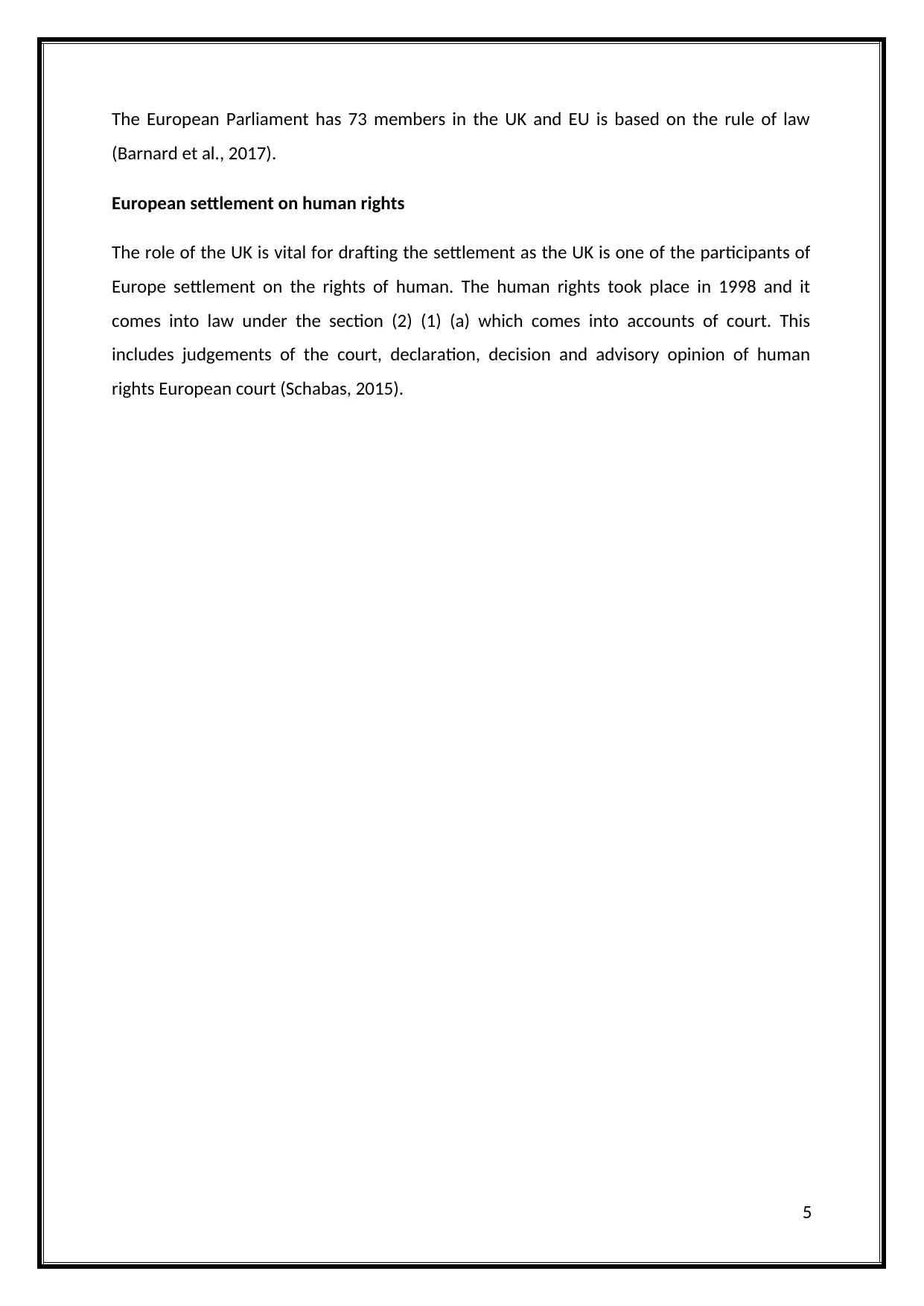
The European Parliament has 73 members in the UK and EU is based on the rule of law
(Barnard et al., 2017).
European settlement on human rights
The role of the UK is vital for drafting the settlement as the UK is one of the participants of
Europe settlement on the rights of human. The human rights took place in 1998 and it
comes into law under the section (2) (1) (a) which comes into accounts of court. This
includes judgements of the court, declaration, decision and advisory opinion of human
rights European court (Schabas, 2015).
5
(Barnard et al., 2017).
European settlement on human rights
The role of the UK is vital for drafting the settlement as the UK is one of the participants of
Europe settlement on the rights of human. The human rights took place in 1998 and it
comes into law under the section (2) (1) (a) which comes into accounts of court. This
includes judgements of the court, declaration, decision and advisory opinion of human
rights European court (Schabas, 2015).
5

P2
Role of government in making laws:
There are so many steps taken by the government in the process of making laws and the
government has divided the process which includes the process of broad voting which
involves the details of the planning and schedule included by the bodies of government
(Zottoli et al., 2019). The lawyers of the civil court have made the laws of bills which can be
offered to the House of the Lords or the House of the Common which are instructed by the
government of the UK. The types of bills are made up by the government which comprises
of public bills, private bills and private member’s bills (Zottoli et al., 2019). For becoming the
Parliament’s Act, these bills have to cross from the different stages in both houses which are
as follows:
Bills arrive at first reading (Bowman and Kearney, 2015)
Debate on the key areas and purpose of the bill at the second reading
At the committee stage, detailed lines with amendments changes and votes take
place for deciding to change (Bowman and Kearney, 2015)
At the report stage, new amendments are discussed and the votes take place
further to take place for deciding to change
Tidying up is the third reading and final chance for votes and amendments
Both the houses consider amendments of others (Bowman and Kearney, 2015)
At the final stage, the final bill gets approved by the Queen and agreed by both of
the houses, then it becomes Act of Parliament (Bowman and Kearney, 2015)
Application of Statutory law in the justice courts:
Statutory laws are used for defining written laws usually passed by a body of legislation.
These are the laws differs from administrative or regulatory laws which are passed by the
common laws and executive agencies as well as the law created by the decisions of the
court in past (Zottoli et al., 2019). This law applied in the courts strictly as the court is not
able to liberalize its application between the statute liens. The law follows the legislative
process and if the bills get refuses or fail by the executive to sign on it, it can be forward
back to the legislation (Bowman and Kearney, 2015).
6
Role of government in making laws:
There are so many steps taken by the government in the process of making laws and the
government has divided the process which includes the process of broad voting which
involves the details of the planning and schedule included by the bodies of government
(Zottoli et al., 2019). The lawyers of the civil court have made the laws of bills which can be
offered to the House of the Lords or the House of the Common which are instructed by the
government of the UK. The types of bills are made up by the government which comprises
of public bills, private bills and private member’s bills (Zottoli et al., 2019). For becoming the
Parliament’s Act, these bills have to cross from the different stages in both houses which are
as follows:
Bills arrive at first reading (Bowman and Kearney, 2015)
Debate on the key areas and purpose of the bill at the second reading
At the committee stage, detailed lines with amendments changes and votes take
place for deciding to change (Bowman and Kearney, 2015)
At the report stage, new amendments are discussed and the votes take place
further to take place for deciding to change
Tidying up is the third reading and final chance for votes and amendments
Both the houses consider amendments of others (Bowman and Kearney, 2015)
At the final stage, the final bill gets approved by the Queen and agreed by both of
the houses, then it becomes Act of Parliament (Bowman and Kearney, 2015)
Application of Statutory law in the justice courts:
Statutory laws are used for defining written laws usually passed by a body of legislation.
These are the laws differs from administrative or regulatory laws which are passed by the
common laws and executive agencies as well as the law created by the decisions of the
court in past (Zottoli et al., 2019). This law applied in the courts strictly as the court is not
able to liberalize its application between the statute liens. The law follows the legislative
process and if the bills get refuses or fail by the executive to sign on it, it can be forward
back to the legislation (Bowman and Kearney, 2015).
6
⊘ This is a preview!⊘
Do you want full access?
Subscribe today to unlock all pages.

Trusted by 1+ million students worldwide
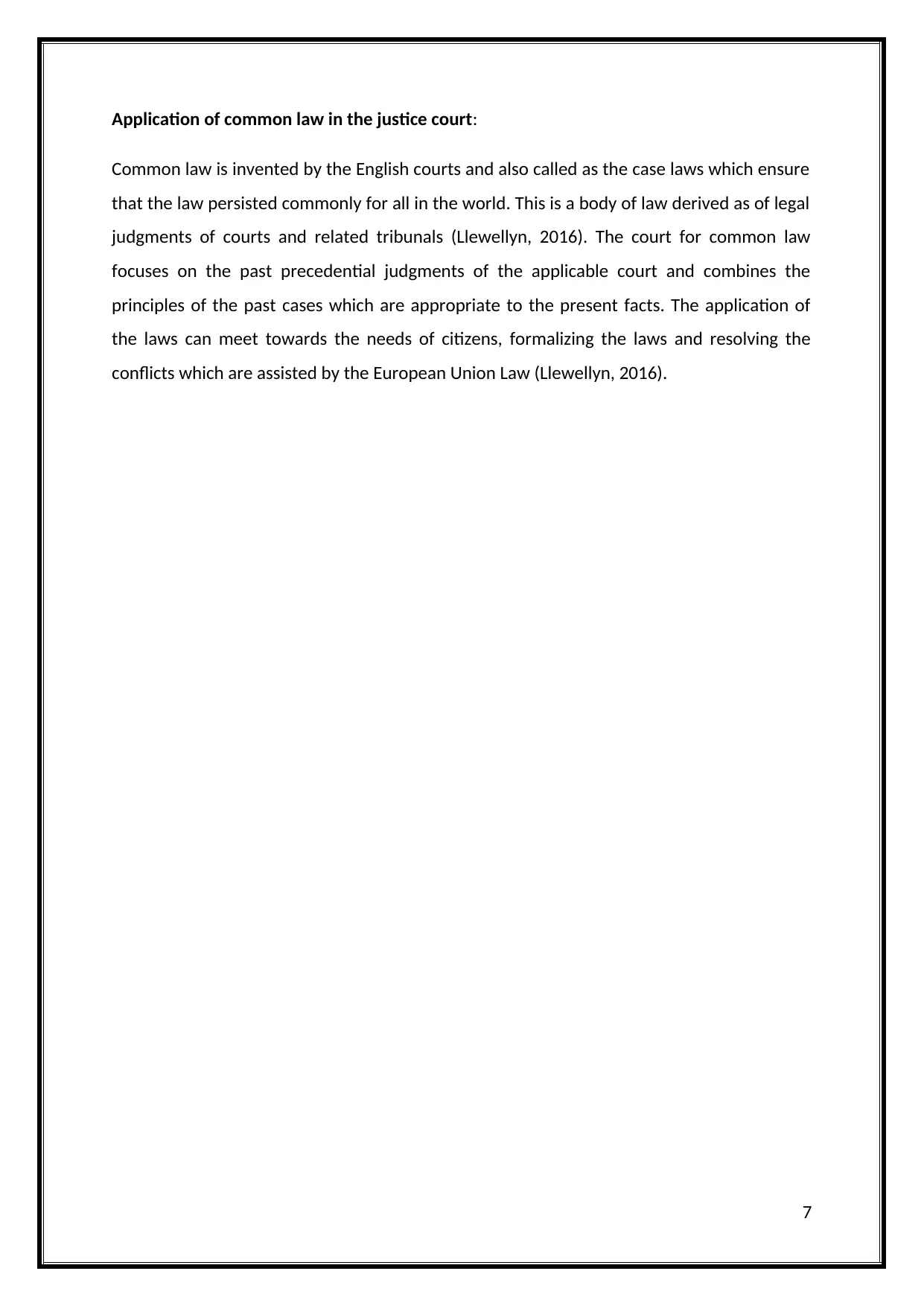
Application of common law in the justice court:
Common law is invented by the English courts and also called as the case laws which ensure
that the law persisted commonly for all in the world. This is a body of law derived as of legal
judgments of courts and related tribunals (Llewellyn, 2016). The court for common law
focuses on the past precedential judgments of the applicable court and combines the
principles of the past cases which are appropriate to the present facts. The application of
the laws can meet towards the needs of citizens, formalizing the laws and resolving the
conflicts which are assisted by the European Union Law (Llewellyn, 2016).
7
Common law is invented by the English courts and also called as the case laws which ensure
that the law persisted commonly for all in the world. This is a body of law derived as of legal
judgments of courts and related tribunals (Llewellyn, 2016). The court for common law
focuses on the past precedential judgments of the applicable court and combines the
principles of the past cases which are appropriate to the present facts. The application of
the laws can meet towards the needs of citizens, formalizing the laws and resolving the
conflicts which are assisted by the European Union Law (Llewellyn, 2016).
7
Paraphrase This Document
Need a fresh take? Get an instant paraphrase of this document with our AI Paraphraser
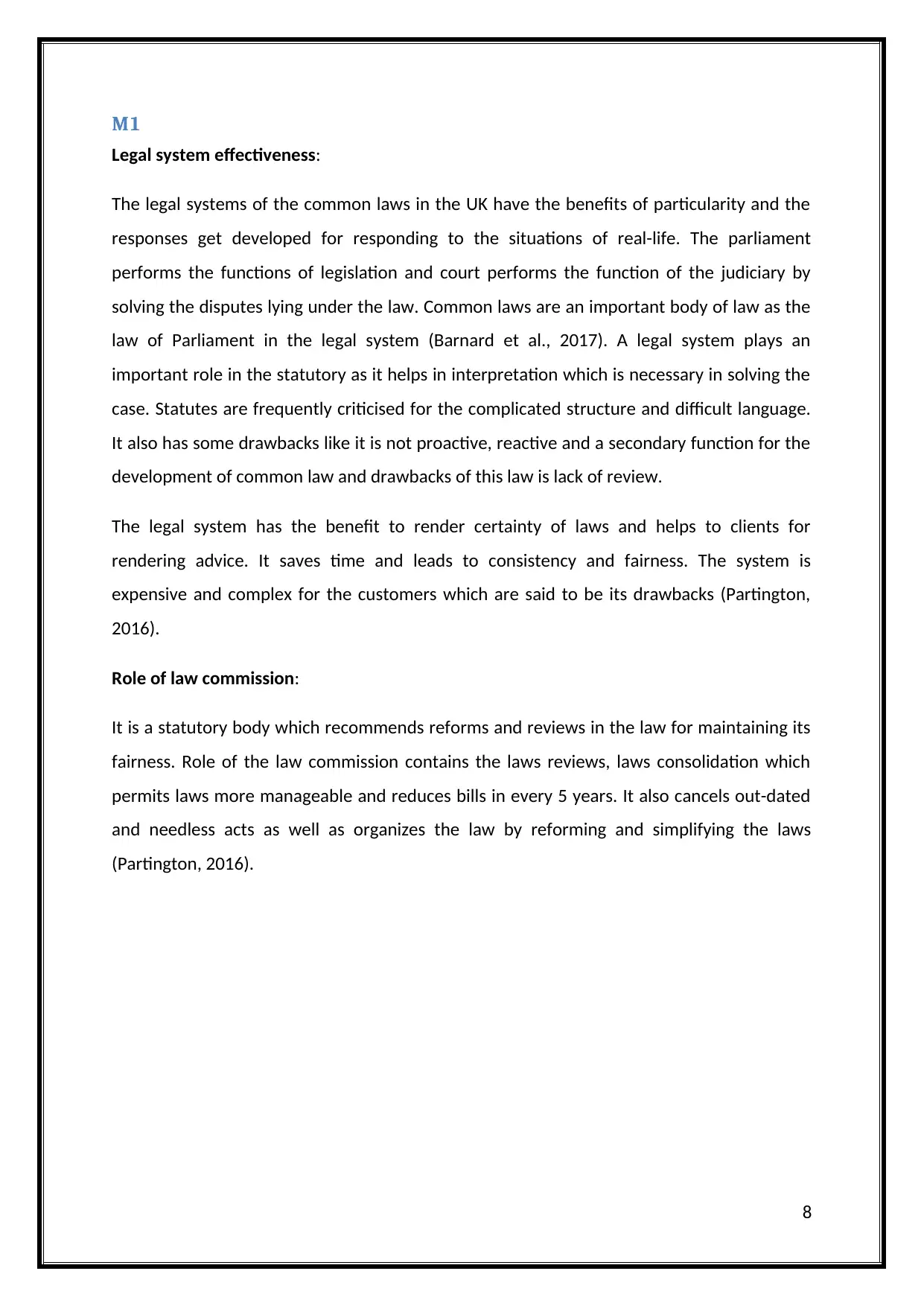
M1
Legal system effectiveness:
The legal systems of the common laws in the UK have the benefits of particularity and the
responses get developed for responding to the situations of real-life. The parliament
performs the functions of legislation and court performs the function of the judiciary by
solving the disputes lying under the law. Common laws are an important body of law as the
law of Parliament in the legal system (Barnard et al., 2017). A legal system plays an
important role in the statutory as it helps in interpretation which is necessary in solving the
case. Statutes are frequently criticised for the complicated structure and difficult language.
It also has some drawbacks like it is not proactive, reactive and a secondary function for the
development of common law and drawbacks of this law is lack of review.
The legal system has the benefit to render certainty of laws and helps to clients for
rendering advice. It saves time and leads to consistency and fairness. The system is
expensive and complex for the customers which are said to be its drawbacks (Partington,
2016).
Role of law commission:
It is a statutory body which recommends reforms and reviews in the law for maintaining its
fairness. Role of the law commission contains the laws reviews, laws consolidation which
permits laws more manageable and reduces bills in every 5 years. It also cancels out-dated
and needless acts as well as organizes the law by reforming and simplifying the laws
(Partington, 2016).
8
Legal system effectiveness:
The legal systems of the common laws in the UK have the benefits of particularity and the
responses get developed for responding to the situations of real-life. The parliament
performs the functions of legislation and court performs the function of the judiciary by
solving the disputes lying under the law. Common laws are an important body of law as the
law of Parliament in the legal system (Barnard et al., 2017). A legal system plays an
important role in the statutory as it helps in interpretation which is necessary in solving the
case. Statutes are frequently criticised for the complicated structure and difficult language.
It also has some drawbacks like it is not proactive, reactive and a secondary function for the
development of common law and drawbacks of this law is lack of review.
The legal system has the benefit to render certainty of laws and helps to clients for
rendering advice. It saves time and leads to consistency and fairness. The system is
expensive and complex for the customers which are said to be its drawbacks (Partington,
2016).
Role of law commission:
It is a statutory body which recommends reforms and reviews in the law for maintaining its
fairness. Role of the law commission contains the laws reviews, laws consolidation which
permits laws more manageable and reduces bills in every 5 years. It also cancels out-dated
and needless acts as well as organizes the law by reforming and simplifying the laws
(Partington, 2016).
8

LO2
P3
Several conditions and terms of the employment and contract are used to protect the
employee’s rights which get formulated under the law of employment. The law ensures
compliance by the employees for different regulation and rules of the businesses in order to
avoid the litigation or other lawsuits (Rose, 2016).
Some of the rules generated which impacts on the operations of the business are in context
to the ethics where the business can run in assuring the customers about the health and
safety measures. The small businesses get impacted by laws of company, contract and
employment (Knapp et al., 2019).
Impact of contract and employment law:
For retaining an effective relationship between the employees and the employer as well as
to maintain the safety and protection of the employees, the contract and employment laws
are formed (Rose, 2016). Non-compliances of these laws will draw attention towards the
tribunal and lawsuit actions. The law of employment involves all relevant conditions and
terms, as well as the contracts of employment, depict the hours of working and focuses on
the employee's safety. The contract and employment laws are significant for the cases
related to the accident or incident took place at the workplace which affects the aspect of
employment (Rose, 2016).
Workers compensation
Under the legal obligations as an employer, the workers must be given the fair payments
which come under the Act of Workers compensation. This act covers reporting to the illness,
injuries and other facilities to the workers (Bryson et al., 2016). On the other hand, it also
falls in obligations of the employer that he has to submit the report of the information of
payroll on the time to the Workers Compensation Board for determining the premium
(Bryson et al., 2016).
9
P3
Several conditions and terms of the employment and contract are used to protect the
employee’s rights which get formulated under the law of employment. The law ensures
compliance by the employees for different regulation and rules of the businesses in order to
avoid the litigation or other lawsuits (Rose, 2016).
Some of the rules generated which impacts on the operations of the business are in context
to the ethics where the business can run in assuring the customers about the health and
safety measures. The small businesses get impacted by laws of company, contract and
employment (Knapp et al., 2019).
Impact of contract and employment law:
For retaining an effective relationship between the employees and the employer as well as
to maintain the safety and protection of the employees, the contract and employment laws
are formed (Rose, 2016). Non-compliances of these laws will draw attention towards the
tribunal and lawsuit actions. The law of employment involves all relevant conditions and
terms, as well as the contracts of employment, depict the hours of working and focuses on
the employee's safety. The contract and employment laws are significant for the cases
related to the accident or incident took place at the workplace which affects the aspect of
employment (Rose, 2016).
Workers compensation
Under the legal obligations as an employer, the workers must be given the fair payments
which come under the Act of Workers compensation. This act covers reporting to the illness,
injuries and other facilities to the workers (Bryson et al., 2016). On the other hand, it also
falls in obligations of the employer that he has to submit the report of the information of
payroll on the time to the Workers Compensation Board for determining the premium
(Bryson et al., 2016).
9
⊘ This is a preview!⊘
Do you want full access?
Subscribe today to unlock all pages.

Trusted by 1+ million students worldwide
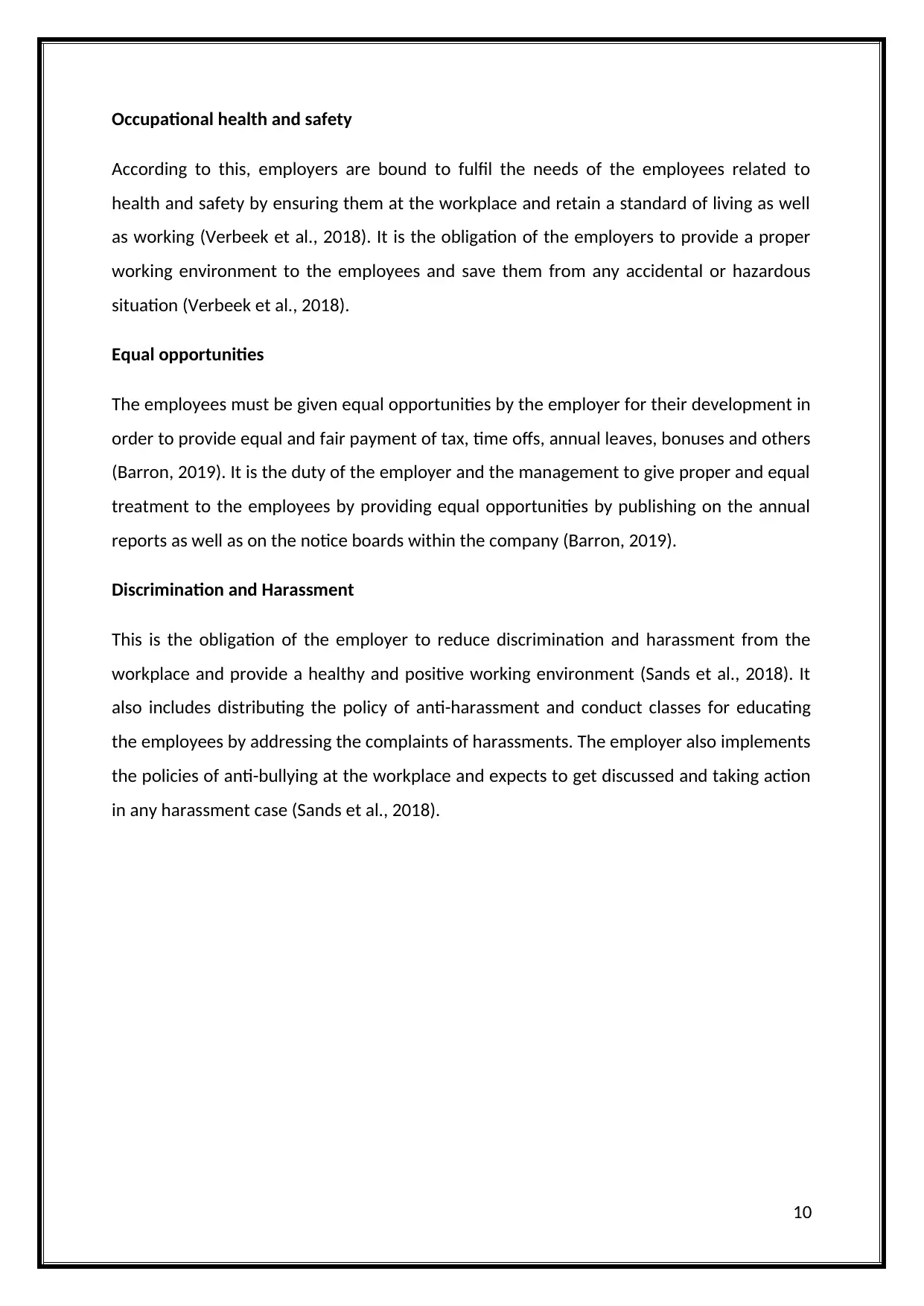
Occupational health and safety
According to this, employers are bound to fulfil the needs of the employees related to
health and safety by ensuring them at the workplace and retain a standard of living as well
as working (Verbeek et al., 2018). It is the obligation of the employers to provide a proper
working environment to the employees and save them from any accidental or hazardous
situation (Verbeek et al., 2018).
Equal opportunities
The employees must be given equal opportunities by the employer for their development in
order to provide equal and fair payment of tax, time offs, annual leaves, bonuses and others
(Barron, 2019). It is the duty of the employer and the management to give proper and equal
treatment to the employees by providing equal opportunities by publishing on the annual
reports as well as on the notice boards within the company (Barron, 2019).
Discrimination and Harassment
This is the obligation of the employer to reduce discrimination and harassment from the
workplace and provide a healthy and positive working environment (Sands et al., 2018). It
also includes distributing the policy of anti-harassment and conduct classes for educating
the employees by addressing the complaints of harassments. The employer also implements
the policies of anti-bullying at the workplace and expects to get discussed and taking action
in any harassment case (Sands et al., 2018).
10
According to this, employers are bound to fulfil the needs of the employees related to
health and safety by ensuring them at the workplace and retain a standard of living as well
as working (Verbeek et al., 2018). It is the obligation of the employers to provide a proper
working environment to the employees and save them from any accidental or hazardous
situation (Verbeek et al., 2018).
Equal opportunities
The employees must be given equal opportunities by the employer for their development in
order to provide equal and fair payment of tax, time offs, annual leaves, bonuses and others
(Barron, 2019). It is the duty of the employer and the management to give proper and equal
treatment to the employees by providing equal opportunities by publishing on the annual
reports as well as on the notice boards within the company (Barron, 2019).
Discrimination and Harassment
This is the obligation of the employer to reduce discrimination and harassment from the
workplace and provide a healthy and positive working environment (Sands et al., 2018). It
also includes distributing the policy of anti-harassment and conduct classes for educating
the employees by addressing the complaints of harassments. The employer also implements
the policies of anti-bullying at the workplace and expects to get discussed and taking action
in any harassment case (Sands et al., 2018).
10
Paraphrase This Document
Need a fresh take? Get an instant paraphrase of this document with our AI Paraphraser

M2
Regulations: It is the concept of managing the complex system conferring to the set of
trends and rules. The common examples of regulations are the control over wages, prices,
pollution, employment, market entries etc. (Yu et al., 2017).
Legislations: It is also known as statutory law and the bill is known as legislation which
follows the legislative process and if the bills get refuses or fail by the executive to sign on it,
it can be forward back to the legislation (Yu et al., 2017).
Standards: These are classified as government and specification impose by law. It is a
document which established by agreement and approved by a standard body for repeat and
common use, guidelines, characteristics and rules for the activities and their results which
aims to achieve an optimal degree of command in a provided context (Bond, 2015).
Standards are used overly which becomes a problem for the company and with using
widespread it takes the regulation form. Standards are different from regulations and if a
company follows the standards which do not guarantee that the company is in with the
relevant laws. The government appeals on standards when putting documents of guidance
and legislation together. Legislation could change within standards lifetime (Bond, 2015).
The businesses follow the regulations for benefiting the employees as the company must
follow the rules and regulations as well as legislation in the context of the employee’s
welfare and safety (Bond, 2015).
11
Regulations: It is the concept of managing the complex system conferring to the set of
trends and rules. The common examples of regulations are the control over wages, prices,
pollution, employment, market entries etc. (Yu et al., 2017).
Legislations: It is also known as statutory law and the bill is known as legislation which
follows the legislative process and if the bills get refuses or fail by the executive to sign on it,
it can be forward back to the legislation (Yu et al., 2017).
Standards: These are classified as government and specification impose by law. It is a
document which established by agreement and approved by a standard body for repeat and
common use, guidelines, characteristics and rules for the activities and their results which
aims to achieve an optimal degree of command in a provided context (Bond, 2015).
Standards are used overly which becomes a problem for the company and with using
widespread it takes the regulation form. Standards are different from regulations and if a
company follows the standards which do not guarantee that the company is in with the
relevant laws. The government appeals on standards when putting documents of guidance
and legislation together. Legislation could change within standards lifetime (Bond, 2015).
The businesses follow the regulations for benefiting the employees as the company must
follow the rules and regulations as well as legislation in the context of the employee’s
welfare and safety (Bond, 2015).
11
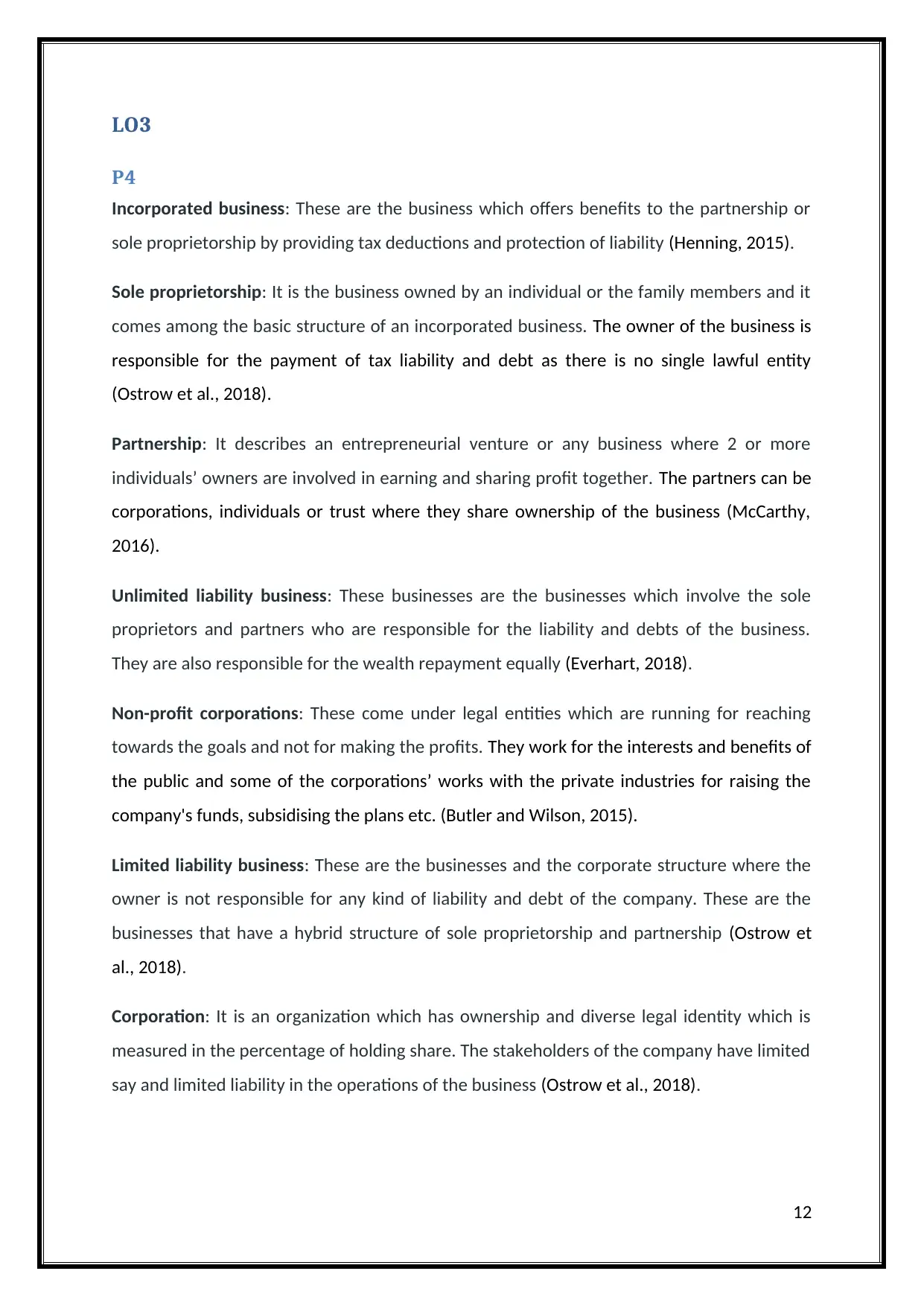
LO3
P4
Incorporated business: These are the business which offers benefits to the partnership or
sole proprietorship by providing tax deductions and protection of liability (Henning, 2015).
Sole proprietorship: It is the business owned by an individual or the family members and it
comes among the basic structure of an incorporated business. The owner of the business is
responsible for the payment of tax liability and debt as there is no single lawful entity
(Ostrow et al., 2018).
Partnership: It describes an entrepreneurial venture or any business where 2 or more
individuals’ owners are involved in earning and sharing profit together. The partners can be
corporations, individuals or trust where they share ownership of the business (McCarthy,
2016).
Unlimited liability business: These businesses are the businesses which involve the sole
proprietors and partners who are responsible for the liability and debts of the business.
They are also responsible for the wealth repayment equally (Everhart, 2018).
Non-profit corporations: These come under legal entities which are running for reaching
towards the goals and not for making the profits. They work for the interests and benefits of
the public and some of the corporations’ works with the private industries for raising the
company's funds, subsidising the plans etc. (Butler and Wilson, 2015).
Limited liability business: These are the businesses and the corporate structure where the
owner is not responsible for any kind of liability and debt of the company. These are the
businesses that have a hybrid structure of sole proprietorship and partnership (Ostrow et
al., 2018).
Corporation: It is an organization which has ownership and diverse legal identity which is
measured in the percentage of holding share. The stakeholders of the company have limited
say and limited liability in the operations of the business (Ostrow et al., 2018).
12
P4
Incorporated business: These are the business which offers benefits to the partnership or
sole proprietorship by providing tax deductions and protection of liability (Henning, 2015).
Sole proprietorship: It is the business owned by an individual or the family members and it
comes among the basic structure of an incorporated business. The owner of the business is
responsible for the payment of tax liability and debt as there is no single lawful entity
(Ostrow et al., 2018).
Partnership: It describes an entrepreneurial venture or any business where 2 or more
individuals’ owners are involved in earning and sharing profit together. The partners can be
corporations, individuals or trust where they share ownership of the business (McCarthy,
2016).
Unlimited liability business: These businesses are the businesses which involve the sole
proprietors and partners who are responsible for the liability and debts of the business.
They are also responsible for the wealth repayment equally (Everhart, 2018).
Non-profit corporations: These come under legal entities which are running for reaching
towards the goals and not for making the profits. They work for the interests and benefits of
the public and some of the corporations’ works with the private industries for raising the
company's funds, subsidising the plans etc. (Butler and Wilson, 2015).
Limited liability business: These are the businesses and the corporate structure where the
owner is not responsible for any kind of liability and debt of the company. These are the
businesses that have a hybrid structure of sole proprietorship and partnership (Ostrow et
al., 2018).
Corporation: It is an organization which has ownership and diverse legal identity which is
measured in the percentage of holding share. The stakeholders of the company have limited
say and limited liability in the operations of the business (Ostrow et al., 2018).
12
⊘ This is a preview!⊘
Do you want full access?
Subscribe today to unlock all pages.

Trusted by 1+ million students worldwide
1 out of 21
Related Documents
Your All-in-One AI-Powered Toolkit for Academic Success.
+13062052269
info@desklib.com
Available 24*7 on WhatsApp / Email
![[object Object]](/_next/static/media/star-bottom.7253800d.svg)
Unlock your academic potential
Copyright © 2020–2025 A2Z Services. All Rights Reserved. Developed and managed by ZUCOL.



